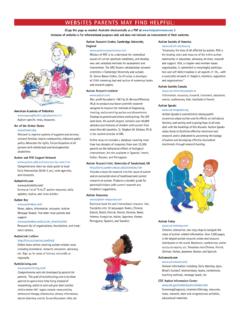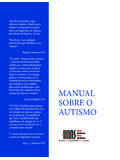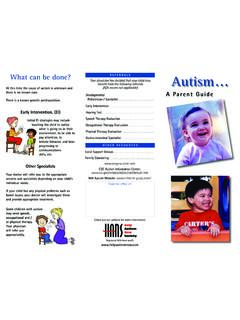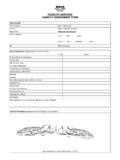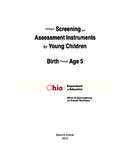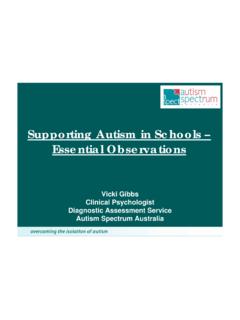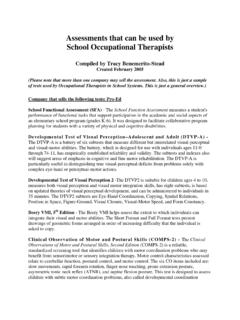Transcription of AUTISM PHYSICIAN HANDBOOK - Help Autism Now
1 AUTISMPHYSICIAN HANDBOOK This beautifully illustrated book provides an appealing, quick reference for the busy primary care PHYSICIAN / nurse-practitioner with regard to diagnosing AUTISM in young children. This book should be a MUST for any professional working with children. Margaret Bauman of LADDERS: Learning and Developmental Disabilities Evaluation and Rehabilitation ServicesMassachusetts General Hospital for Children, BostonAssociate Professor of Neurology, Harvard Medical School The HANS AUTISM PHYSICIAN HANDBOOK is an excellent and creatively designed reference that incorporates simply and succinctly important information on early recognition of AUTISM . Its visual appeal with easy reading is not only an important resource to be used by any PHYSICIAN , but other medical professionals, educators, and parents will find it very useful.
2 Sarojini Budden MD, FRCPC, FAAPP resident, Oregon Pediatric Society The CHAT; CHecklist for AUTISM in Toddlers screening tool was developed for use in ALL 18-month well child visits. It is simple to administer and score. I would encourage everyone working with 0-3 year olds to place the posters in view and become familiar with the content. Early intervention can t happen without early recognition. Nancy J. Minshew, MDProfessor of Psychiatry and Neurology University of PittsburghDirector, NIH AUTISM Center of is dedicated to helping families by supporting physicians and other professionals in the early recognition, diagnosis and treatment of AUTISM . Contact us: Address: 4742 Liberty Road South, # 198, Salem OR 97302 For helpful information.
3 Check out our website of ContentsPage 1 Table of ContentsPage 2 AcknowledgementsPage 3 CHAT PosterPage 4 5 CHAT screening ToolPage 6-23 VISUAL GUIDE TO BEHAVIORAL SYMPTOMS Page 7 8 Social Issues Page 9 Communications Issues Page 10-13 Bizarre/Repetitive Behavior Page 14 15 Motor Issues Page 16 Sensory Overload Page 17 19 Sensory Issues Page 20 Self-Injurious Page 21 23 Safety IssuesPage 24 Co-Morbidity: Gastro-Intestinal DisturbancesPage 25 Co-Morbidity: Sleep Disturbances / Altered Pain Responses / SeizuresPage 26 Impact on FamilyPage 27 The Role of Early Intervention (Educational)Page 28 List of Potential ReferralsPage 29 33 OPTIMIzInG OFFICE VISITS FOR CHILDREn wITH AuTISMPage 34-36 Parent Online ResourcesInside Back Cover Early Intervention Referral numbers and Online PHYSICIAN Resources2 This AUTISM PHYSICIAN HANDBOOK was designed to support Primary Care providers in their care of children with the absence of a biological marker, AUTISM can only be diagnosed by observation of the child s behavior, and careful history-taking from the HANDBOOK has been put together by Linda Lee Executive Director of HAnS, based on input from many professional experts in both the educational and medical fields.
4 2007 All rights is dedicated to helping families with AUTISM , by supporting physicians and other professionals in the early recognition, diagnosis and treatment of wishes to thank the following individuals for their generous contributions and involvement in the creation of this PHYSICIAN Simon Baron-Cohen, developer of the CHAT screening tool : Professor of Developmental Psychopathology, Director AUTISM Research Center, Cambridge University, England. Julie Bingham, PhD: Pediatric Clinical Psychologist, Salem, OregonRichard Bingham, MD: Child Psychiatrist, Salem OregonSarojini Budden, MD: Pediatric Developmental Specialist, Director of Child Development and Rehabilitation, Legacy Emmanuel, Portland, Cuthill, MD: Pediatric Developmental Specialist.
5 Kaiser Permanente, Portland, Marlowe, MD: Pediatrician, Kaiser Permanente Salem, OregonMary Lynn O Brien, MD: Pediatric Developmental Specialist. Kaiser Permanente, Portland, Willis, MD: Behavioral and Developmental Pediatrician. Northwest Early Childhood Institute, Portland, OregonRegistered 501c3 18 months of age Does your child ..32. Look when you point to something?3. use imagination to pretend play?If the answer is NO, your child may be at risk for AUTISM . Please alert your PHYSICIAN on CHAT (CHecklist for AUTISM in Toddlers)1. Look at you and point when he/she wants to show you something? (CHecklist for AUTISM in Toddlers)Page 1 of 2 (To be completed at 18-month visit) Section A: To be completed by parent1.
6 Does your child enjoy being swung, bounced on your knee, etc? Yes No2. Does your child take an interest in other children? Yes No3. Does your child like climbing on things, such as up stairs? Yes No4. Does your child enjoy playing peek-a-boo/hide-and-seek? Yes No5. Does your child ever PRETEND, for example, to make a cup of tea using a toy cup and teapot, or pretend other things? Yes No6. Does your child ever use his/her index finger to point, to ASK for something? Yes No7. Does your child ever use his/her index finger to point, to indicate INTEREST in something? Yes No8. Can your child play properly with small toys ( cars or bricks) without just mouthing, fiddling or dropping them?
7 Yes No9. Does your child ever bring objects over to you (parent) to SHOW you something? Yes No Section B: PHYSICIAN or healthcare provider1. During the appointment, has the child made eye contact with you? Yes no2. Get child s attention, then point across the room at an interesting object and say Oh look! There s a (name of toy)! Watch child s face. Does the child look across to see what you are pointing at? Yes no3. Get the child s attention, then give child a miniature toy cup and teapot and say Can you make me a cup of tea? Does the child pretend to pour out tea, drink it, Yes no4. Say to the child Where s the light? , or Show me the light.
8 Does the child POINT with his/her index finger at the light? Yes no5. Can the child build a tower of bricks? (If so, how many_____) Yes noB2: To record Yes on this item, ensure the child has not simply looked at your hand, but has actually looked at the object you are pointing : If you can elicit an example of pretending in some other game, score a Yes on this : Repeat this with where s the teddy? or some other unreachable object, if child does not understand the word light. To record Yes on this item, the child must have looked up at your face around the time of pointing.(See next page for scoring recommendations) (CHecklist for AUTISM in Toddlers)Page 2 of 2 CHAT key items Section A A5: Pretend play A7: Protodeclarative pointing Section B B2: Following a point B3: Pretending B4: Producing a pointCHAT non-key items Section A A1: Rough and tumble play A2: Social interest A3: Motor development A4: Social play A6: Protoimperative pointing A8: Functional play A9: Showing Section B B1: Eye contact B5.
9 Tower of bricksRisk AssignmentHigh risk for AUTISM group Fail (nO answer) A5, A7, B2, B3, B4 Medium risk for AUTISM group Fail A7, B4 (but not in high risk group)Low risk for AUTISM group not in other two risk groupsManagement recommendations:High risk group: Refer to developmental clinic as well as ESD (Educational Services Department).Medium risk group: High suspicion refer as above Low suspicion Re-test in one monthLow risk group: If there are any nO answers, re-test in one / Repetitive BehaviorsMotorSensory OverloadSensorySelf InjuriousSafetyBehavioral Symptoms of issuesMay not notice when parent leaves or returns from workMay be vicious with siblingsMay sit alone in crib screaming instead of calling out for motherMay show no interest in other children playingBehavioral Symptoms of issuesMay strongly resist being held.
10 Hugged or kissed by parentsMay not raise arms to be picked up from crib when someone reaches out to pick him upMay show no interest in Peek-a-Boo or other interactive gamesBehavioral Symptoms of issuesChildren with AUTISM are often unaware of their environment and may have difficulty with eye-contact. As a result they may seem uninterested in communication of any they do need something they often resort to Hand-Leading . The child places the parent s hand on the object he desires, so using the parent or adult as a tool to get what they want. Typical children communicate their needs by verbalizing, or non-verbal methods such as of environmentAvoids eye-contactBehavioral Symptoms of / repetitive behaviorsStaring at ceiling fanFlappingSpinningLining up toy carsBehavioral Symptoms of / repetitive behaviorsMay show no interest in toys but get attached to objects like a space- heaterPicking lint in the sunlightMay not play appropriately with toys and instead focuses only on one aspect, like spinning the wheels of a toy carBehavioral Symptoms of / repetitive behaviorsEats unusual objects like clothes.

